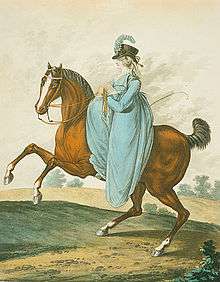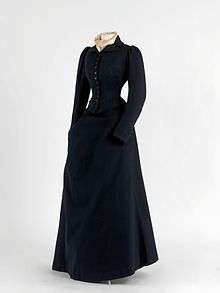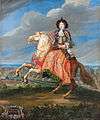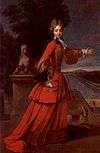Riding habit



A riding habit is women's clothing for horseback riding.
Since the mid-17th century, a formal habit for riding sidesaddle usually consisted of:
- A tailored jacket with a long skirt (sometimes called a petticoat) to match
- A tailored shirt or chemisette
- A hat, often in the most formal men's style of the day (since the Victorian era, a top hat with a veil has been worn)
Low-heeled boots, gloves, and often a necktie or stock complete the ensemble. Typically, throughout the period the riding habit used details from male dress, whether large turned cuffs, gold trims or buttons. The colours were very often darker and more masculine than those on normal clothes. Earlier styles can be similar to the dresses worn by boys before breeching in these respects.
When high waists were the fashion, from roughly 1790 to 1820, the habit could be a coat dress called a riding coat (borrowed in French as redingote) or a petticoat with a short jacket (often longer in back than in front).
Origins
In France in the 17th century, women who rode wore an outfit called a devantiere.[1] The skirt of the devantiere was split up the back to enable astride riding.[2] By the early 19th century, in addition to describing the whole costume, a devantiere could describe any part of the riding habit, be it the skirt,[2] the apron,[3] or the riding coat.[4]
In his diary for June 12, 1666, Samuel Pepys wrote:
- Walking in the galleries at White Hall, I find the Ladies of Honour dressed in their riding garbs, with coats and doublets with deep skirts, just, for all the world, like mine; and buttoned their doublets up to the breast, with periwigs under their hats; so that, only for a long petticoat dragging under their men's coats, nobody could take them for women in any point whatever; which was an odde sight, and a sight did not please me.[5]
Two and a half centuries later, Emily Post would write:
- A riding habit, no matter what the fashion happens to be, is like a uniform, in that it must be made and worn according to regulations. It must above all be meticulously trig and compact. Nothing must be sticking out a thousandth part of an inch that can be flattened in...Keep the idea of perfect clothes for men in mind, get nothing that the smartest man would not wear, and you can’t go wrong...Correct riding clothes are not fashion but form! Whether coat skirts are long or short, full or plain, and waists wasp-like or square, the above admonitions have held for many decades, and are likely to hold for many more.[6]
Style gallery
 1 - c.1680
1 - c.1680 2 - c.1700
2 - c.1700 3 Lady Worsley - 1776
3 Lady Worsley - 1776 4 - 1790
4 - 1790 5 - 1799
5 - 1799 6 - 1830s
6 - 1830s 7 - 1850s
7 - 1850s
- Madame La Comtesse de Saint Géran in a riding habit with a masculine-styled jacket and waistcoat, c.1680
- Marie Adélaïde de Savoie, Duchesse de Bourgogne in a scarlet riding habit, with male cuffs, gold trim, and buttons, early 18th century
- Lady Worsley in a riding habit with a cutaway coat and waistcoat, and military details from the uniform of her husband's regiment, then in America fighting the rebels, 1776.
- Button-front redingote of 1790, worn with a tall hat.
- Fashion plate of 1799.[7]
- 1830s habits show the popular full sleeves of the day.
- 1850s habit, worn with fashionable ringlets under a top hat.
References
- ↑ Lewandowski, Elizabeth J. The complete costume dictionary. Lanham, Md.: Scarecrow Press, Inc. p. 86. ISBN 9780810840041.
- 1 2 Boileau, Daniel (1822). The French Remembrancer, Or, a New & Easy Method of Recollecting the Genders of French Nouns Substantive, Etc. T. Cadell & G. & W. B. Whittaker. p. 315.
- ↑ Boyer, Abel (1780). Dictionnaire royal francais-anglois et anglois-francois, 1: tiré des meillens auteurs qui ont écrit dans ces deux langues. Jean-Marie Bruyset. p. 192.
- ↑ Cobbett, William (1833). A New French and English Dictionary. p. 137.
- ↑ "Samuel Pepys Diary June 1666 complete".
- ↑ "33. Dress. Post, Emily. 1922. Etiquette".
- ↑ "Regencygarderobe.com".
Notes
- Pepys' diary for June 1666
- Emily Post's Etiquette, 1922, Chapter XXXIII. Dress See paragraph 40 "Riding Clothes"
- Riding Habits at the Regency Garderobe
External links
| Wikimedia Commons has media related to Riding habits. |
- History of Riding Habits
- Woman’s riding suit, 1900-1910, in the Staten Island Historical Society Online Collections Database
- Back in the Habit: Side Saddle Fashion through the Ages